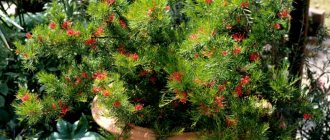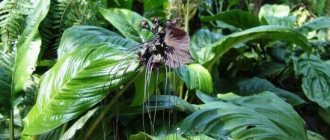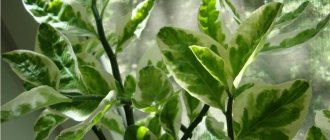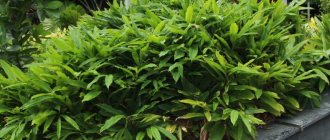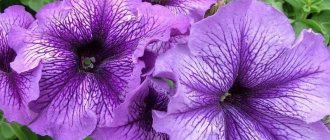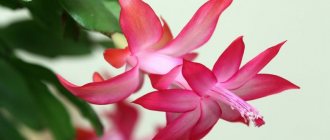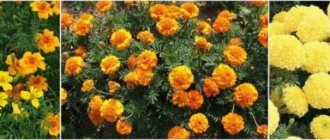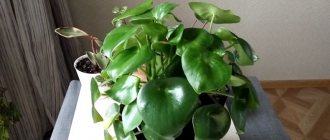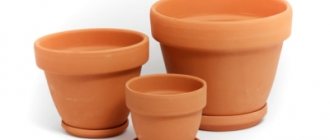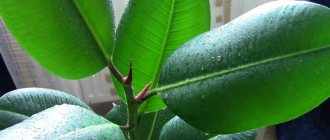A spectacular indoor banana will bring a little exoticism into the room. This plant with luxurious leaves needs plenty of space. Bananas have been cultivated by people for hundreds of years. The fruits of this plant are eaten, in addition, it is a magnificent decorative species. In nature, bananas are found in the tropics of Africa, India, and Asia.
This genus includes about 40 species of rhizomatous plants that produce lateral shoots. Bananas are grown in all tropical regions of the globe, including the Australian state of Queensland. This is an evergreen plant. The “stem” of a banana consists of overlapping leaf stalks. Dwarf banana varieties and species prefer lower air temperatures than plantation-cultivated varieties.
In a large flower pot or tub, a banana can reach 1.8-2.4 meters in height. It does not matter where you are going to grow bananas: in the house, in a greenhouse or in a greenhouse, in any case, choose a dwarf variety. Large elongated leaves reach 30-45 cm in width and 90-120 cm in length. They are very delicate, so holes quickly appear in them.
If the homemade banana is in a windy place, then the leaves of the plant will be torn, since the leaf blade is very tender, and the wind tears it. Therefore, if there are whole leaves on a banana growing in the wind, it is a miracle.
If you find that the leaves of the plant are rotting, then your banana is in a room with too low an air temperature; if the plant does not produce new growth, then the banana does not have enough nutrients. In this case, the plant must be replanted or fed.
We choose plants of a known variety. There should be no spots on the leaves.
Banana needs warmth, good light and high humidity. If you want it to bloom and bear fruit, then provide the plant with as much space as possible on a heated veranda or glassed-in terrace.
How to care
- The soil. We plant bananas in permeable soil based on peat.
- Landing. In large pots or containers, be sure to lay a layer of drainage at the bottom; you can add perlite or vermiculite to the soil.
- Transfer. We replant bananas in the spring every two years. In large tubs or flowerpots, it is enough to change the top layer of soil.
Fertilizer for indoor banana, plant care rules
Considering that banana is a southern plant, it will take a lot of effort to make it grow comfortably in your home.
Firstly, the air temperature should be approximately 30 degrees and at least 24 degrees. Drafts and cold should not be allowed to occur. Secondly, you will need very good lighting, so you need to choose a place that is as sunny as possible, southern. If this is not the case, then the lighting should be done artificially. There is no need for the banana to be exposed to open sunlight all day.
It is very important to water your banana regularly because it loves moisture. This must be done every day, and the water temperature should be warm. In winter, you should give the plant a rest and switch the watering schedule to once a week. To moisturize the plant, it is also necessary to spray it with water. It is not recommended to wipe the leaves. It is important that there is good drainage in order to keep the roots from rotting.
The soil should consist of river sand and peat. When the seedlings are transplanted into a pot, you can add forest soil, turf, and humus to the mixture. Expanded clay can be used as drainage.
As for feeding indoor bananas, it is necessary to feed the plants once every 2 weeks from spring to autumn. Complex mineral fertilizers specifically for house plants are best suited.
A comfortably growing bush has a powerful root system, has an underground shoot, leaves grow from the ground, the combination of which forms the basis of the trunk. When the number of leaves is sufficient, and this is about 18 pieces, then the bush will begin to bloom.
The color of the inflorescence, as a rule, is light green, and the flower itself is a bud.
When you see the first shoots, the plant then begins to actively develop, so you should annually increase the number of liters of container, replanting the plant each time in the spring. This is done because the growing root system requires a lot of nutrients and free space.
When transplanting an indoor banana into a large pot, you can also carefully cut off small shoots from an adult plant and leave them in a special solution called “Kornevina” for an hour or two. Then transplant the indoor banana into a separate pot filled with humus and vermicompost. This way you will propagate the plants.
If the banana is decorative, then it can also be propagated using seeds that you take from a ripe fruit.
Indoor banana: video about home care
Where to put
— Lighting . All types of banana do best in moist and warm places, illuminated by bright sun.
- Temperature . In summer, these plants feel good indoors at room temperature, in winter at a temperature of 15 degrees.
- Humidity . To increase the humidity in the room, place the pot on a stand filled with water with pebbles or frequently spray the leaves of the plant with water.
Description of the plant
The underground part of the banana is represented by a powerful, spherical rhizome with well-branched adventitious roots and a central growing point. The shoot is shortened, underground. What we are used to seeing above the surface of the earth is not a shoot, it is leaves.
The leaves are long-petiolate, wrapping around each other's bases. They form something like a trunk. The leaf blades have impressive sizes: 2, sometimes even 3 m in length and up to half a meter in width. Ellipsoidal, juicy, green, sometimes with burgundy or dark green spots. After fruiting, the leaves of the plant gradually die off and are replaced by new ones.
Flower: The banana will bloom for the first time in about a year. By this time, it develops from 15 to 18 leaves. The peduncle emerges from the flower bud and does a great job, “breaking through” the base of the leaves, growing through the long vaginal tube and stretching out almost to the height of the leaves. There it “ends” with a huge, up to one and a half meters, inflorescence, consisting of a large number of small single flowers, painted in pale yellow and greenish tones. Among them there are both bisexual and heterosexual flowers. Banana blossoms are a magnificent spectacle, lasting two or even three months.
The fruits are set after pollination of the largest, female flowers and are located in their place, forming a kind of brush called bancha. The ripened single fruit has an elongated bean-shaped shape and reaches a length of 3 to 40 cm.
How to propagate
- Reproduction. In the spring, bananas can be propagated at home by division. Side shoots grow from the root ball of the plant, which can be separated from the mother plant and planted in a separate container.
- - using a sharp knife, separate the side shoot with roots from the mother plant. We carry out the procedure carefully.
- - replant the mother plant in permeable soil, remove dead fragments of the root ball.
- - Place the cut side shoot in a suitable container and plant it in the same soil as the mother plant. The roots should be just below the surface of the soil. We crush the soil in the pot, water it and place the container with the planted shoot in a warm and humid place.
- - We provide the banana with regular watering, making sure that the soil remains moist all the time until the plant takes root.
Indoor banana: propagation by seeds
Indoor banana: photo
If you want to grow an indoor banana just for fun and for decorative purposes, then you can plant it using seeds. So you will get a tree even with fruits, but they will be inedible. In this case, care is quite simple. Since banana seeds have a very strong shell, it must be slightly damaged with a knife or needle to make it easier for the sprouts to “get through” it.
Next, indoor banana seeds are placed in a container with moist soil, which includes a mixture of peat and most of river sand.
You should not bury the seeds of indoor banana; you should press them down a little. The distance between the seeds should be 10 cm. Cover the top of the box with film and place it in an open sunny place, but make sure that the garden bed is not exposed to direct sunlight. A homemade greenhouse must be ventilated once every few days by removing the film. It takes a very long time for indoor banana seeds to germinate, about 3 months, and then the seedlings take root after another week or two weeks.
Pests and diseases
— Pests White dots on the underside of banana leaves are a sign of damage to the plant by feltworms. If there are few pests, we remove them manually, otherwise we use an insecticide.
— Diseases If brown spots appear in the center of the leaf and the edges of the leaves turn brown, then the soil in the flower pot is too dry and the air humidity is very low. Water the plant more abundantly. During active growth of the banana, we provide regular, abundant watering; the leaves are often sprayed with water. Torn banana leaves (sometimes the tear extends to the midrib) are normal. Surely such damage was not caused by diseases or pests. If this phenomenon occurs, it means your plant is in a windy place or has been poorly cared for. Immediately move the banana to a place protected from strong winds.
Indoor banana: care at home
Despite the fact that breeders have developed disease-resistant varieties of indoor bananas, there is still a chance that they will get sick.
- If you see dark spots on the leaves, then you need to remove the plants from direct sunlight.
- If you see that new leaves and shoots are not growing on the plants, then it is necessary to reconsider the conditions in which this plant lives or transplant it into a larger pot, or also feed it.
- If the edges of the leaves become dry and darkened, then the plant does not have enough moisture. It is necessary to water and spray the bush more often.
- If you see a soft, rotted stem, there is more than enough water in the pot. Or the plant has become infected with a fungal disease. Here it is necessary to use a fungicide and reduce the amount of watering.
Pests rarely attack indoor bananas, but if this happens, it is necessary to use special anti-pest preparations.
Thus, we can conclude that even an indoor banana can be grown at home, following the following rules:
- You need to buy seedlings in special stores if you are going to eat banana fruits.
- It is necessary to take into account that the seeds will take a very long time to germinate, so you need to be patient and wait at least 3 months, or again buy already grown plants.
- Take care of the plant carefully. Observe the temperature and all other air parameters.
- In addition, it is necessary to remember that a growing plant needs a “growing” pot.
By following these simple rules, in just two or three years you will be able to please yourself and your loved ones with the sweet exotic fruits of indoor bananas
Flower design
When choosing a plant, or rather a variety or type of banana, you need to understand where you will grow it. Several types of banana can be grown on a veranda or on a glassed-in terrace: these include: velvety banana, reaching 1.2 m in height, leaves 60 cm long, yellow flowers with red stipules, inedible fruits, as well as a dwarf species reaching 1.2 m in height, which is usually propagated by shoots and the bright red banana is only 90cm high. This tropical plant will bring into your interior like other tropical palms. Good luck to you.
Types of bananas:
- Velvety banana (Musa velutina) is a plant with inedible fruits, up to 1.3 meters high.
- Banana Kiev dwarf – begins to bear fruit at 3 years of age. Flowering is long, lasting from 3 months to a year. The fruits are sweet, not miniature.
- plants.
- There are many cultivars of the sterile triploid cultigen Musa × paradisiaca (an artificial species not found in the wild) which are widely cultivated in tropical countries and constitute a major export in many of them.
- Japanese banana (Musa basjoo), native to the Japanese Ryukyu Islands, is grown as an ornamental plant on the Black Sea coast of the Caucasus, Crimea and Georgia.
A little history
The banana culture is believed to be about 10,000 years old. The exotic fruit came to Southeast Asia as a valuable food plant, which began to be grown long before rice and sugar cane appeared. Referring to Hindu folklore, we can safely say that the birthplace of bananas is the island of Ceylon.
The image of bananas can be found on frescoes in ancient Assyria and Egypt. We can also observe isolated mentions of this wonderful Indian fruit in the handwritten histories of the Greeks, warlike Romans and other peoples.
The banana tree took root in African countries back in the Middle Ages, becoming an indispensable and very important product for the inhabitants of this region, which is very dry. In subsequent centuries, the banana began to spread to both the Canary Islands and South America.
At the beginning of the 20th century, in Europe, the decorative banana became a favorite of city dwellers due to its unusual appearance. And since then there is not a single garden in which this wonderful fruit does not grow.
Bloom
During the flowering period, pawpaw is extremely beautiful. This occurs in April–May and lasts about 20 days. The flowers of this plant are large, monoecious, and decorative. The diameter of the bud is 4-6 cm. The color range is from red-pink to dark purple.
In the center there is a cup framed by three petals. They are bordered by three more, larger ones, making up a deep bud. An interesting feature is that each flower has several pistils. Subsequently, 3-8 fruits ripen at once in place of the calyx. Under natural conditions, pistils are pollinated by carrion insects. They are attracted by the putrid smell that the flowers emit. When growing trees in the garden, it is necessary to pollinate the pistils artificially.
